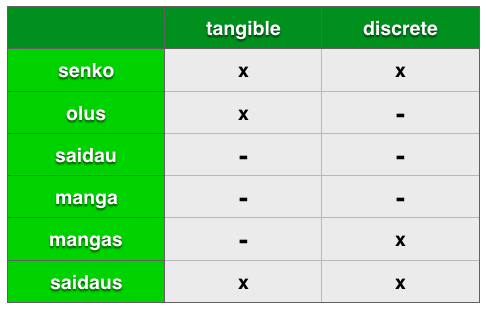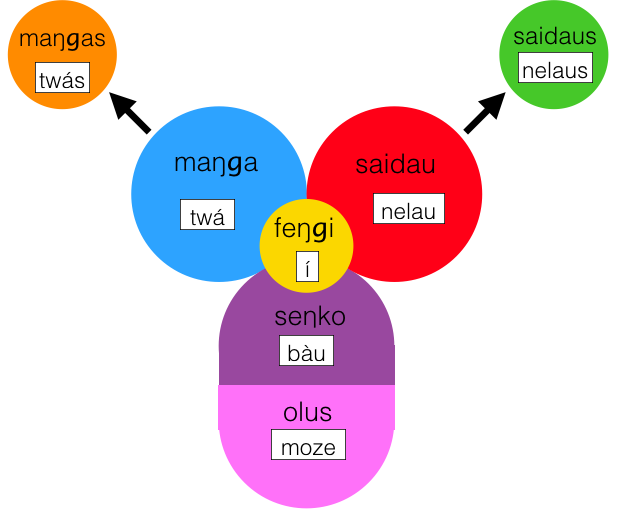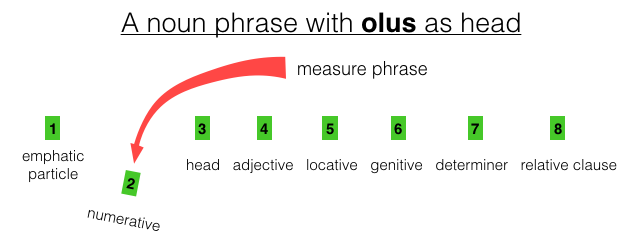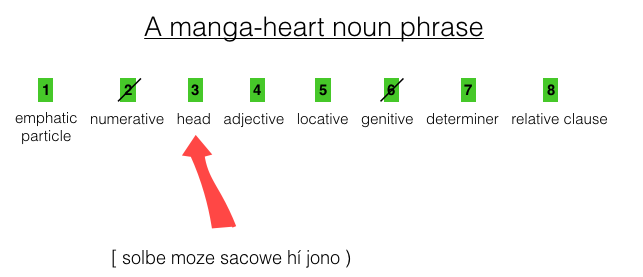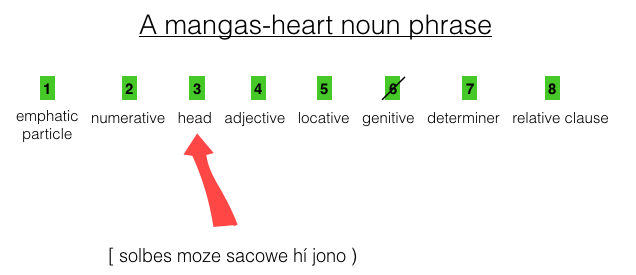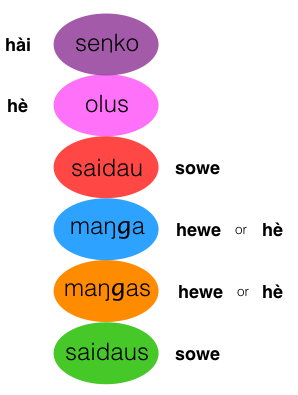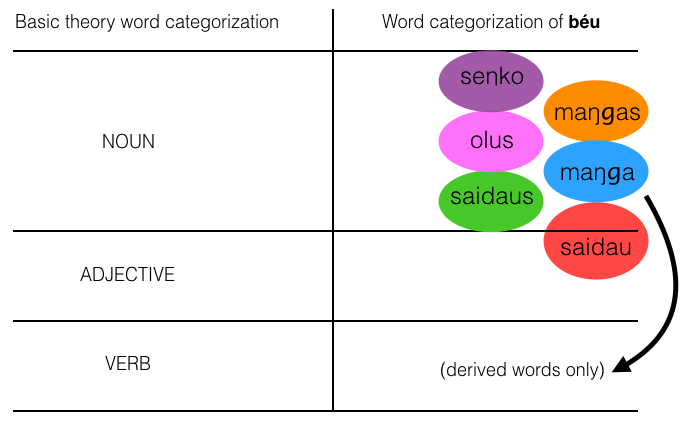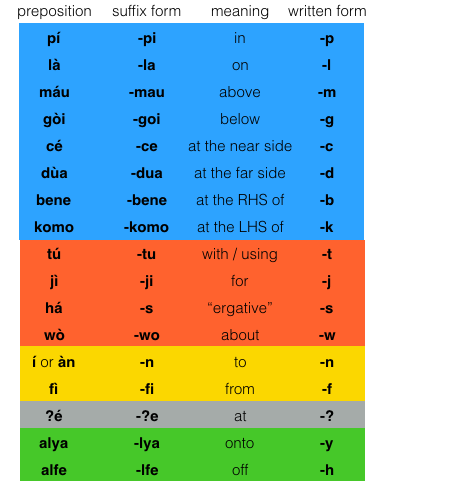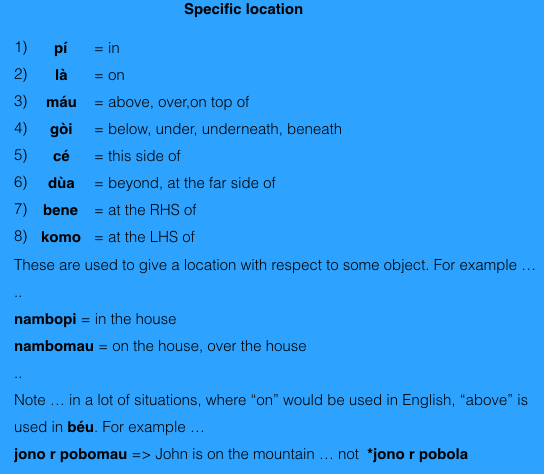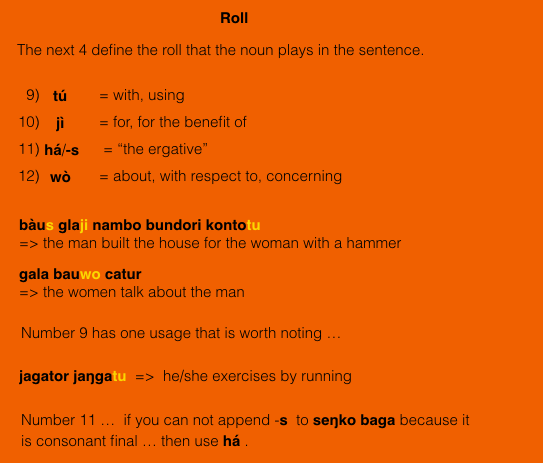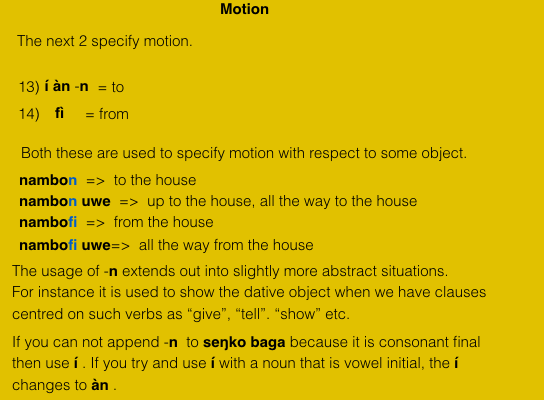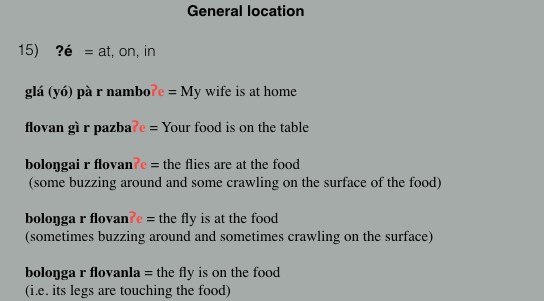Béu : Chapter 2 : The Noun
..... The 7 types of word
..
All words belong to one of the following 7 categories ...
..
1) feŋgi = particle ... this is a sort of "hold-all" category for all words (and affixes) that don't neatly fit into the other categories. Interjections, numbers, pronouns, conjunctions, determiners and certain words that would be classed as adverbs in English, are all classed as feŋgi.
An example is Í .. the preposition indicating the dative.
..
..
2) seŋko = object
An example is bàu ... "a man"
..
3) olus = material, stuff
An example is moze ... "water"
..
4) saidau = adjective
An example is nelau ... "dark blue"
..
5) maŋga = verb
An example is twá ... "to meet" (the concept of "meet" disassociated from any arguments, tense, aspect or whatever).
..
6) maŋgas = a noun derived from a verb. A maŋgas represents one instance of the activity denoted by the maŋga. For example ...
twás ... "a\the meeting" : nò twás ... "a\the meetings"
..
7) saidaus = a noun derived from an adjective. The saidaus means one object possessing the property denoted by the saidau.
An example is nelaus = a/the dark blue one : nò nelaus = a/the dark blue ones
..
..
The maŋgas and saidaus are transparently derived from the maŋga and saidau so there is no need to list them separately in a dictionary.
..
..... Seŋko
..
seŋko is a noun or a noun phrase
It can have up to 8 elements.
Below is shown these elements and the order in which they occur.
..
..
Elements 1, 2, and 7 have restricted membership, if fact element 1 has only one possibility, the word só. The words with red background convert the noun phrase (or indeed the sentence in which the NP is embedded) into a question. A blue circle indicates the only mandatory element. Branching arrows indicate multiple possibilities.
..
... The head
..
3) ... the head
..
... The adjective
..
4) ... the adjective
More than one adjective is allowed. For example ... bàu gèu tiji = the little green man
kái "what type" can appear in this slot. In which case it turns the whole noun phrase (or sentence) into a question. For example ...
bàu gèu kái = what kind of green man ? ... noun phrase question
há bàu gèu kái glà timpori = what kind of green man hit the woman ? ... sentence question
Numbers can go in this slot also. When in this slot they are ordinal numbers. This is opposed to where the number comes before the head, in which case it is a cardinal number. For example ...
há bàu hói glà timpori = The second man hit the woman
há hói bàu glà timpori = The two men hit the woman
..
Now when you have multiple adjectives they will have a certain order depending upon their sub-category.
This is the same as English ... for example, you always say "the third big black dog" and never "the black third big dog".
béu uses the exact same order as in English but reversed timewise. For example ...
| waulo | àu | jutu | léu |
|---|---|---|---|
| dog | black | big | third |
..
Or, you can say, béu has exactly the same order as English, in terms of proximity to the head.
..
... The locative
..
5) ... the locative. For example ... bàu gèu tiji pobomau = the little green man on top of the mountain
A locative comprises of a noun plus one of the nine affixes .... pi la mau goi ce dua bene komo ?e
The locative is a type of adjective.
Also a noun plus the affix fi can appear in this slot. This is not giving information about "location" but rather "origin". It is classed as a locative nevertheless.
Note ... if the noun taking the affix is a noun phrase ... well it is not possible to use the affix but you must use the stand alone term (see the section "the Case system" later on in this chapter). For example ...
to say "the little green man on top of the big mountain" => bàu gèu tiji máu pobo jutu
The above is called an ENP (extended noun phrase) ... it comprises bàu gèu tiji (NP 1) + máu + pobo jutu (NP 2)
Also dá "where" can appear in this slot. In which case it turns the whole noun phrase (or sentence) into a question. For example ...
bàu gèu dá = where is the green man ?
..
... The genitive
..
6) ... the genitive. For example jwado gèu nambomau yó jene = Jane's big green bird on top of the house
Note that the particle yó is usually dropped when the possessor is next to the head. However as other elements intervene, the likelihood that yó is used increases.
If mín (who) is used instead of jene in the above ... then we would have a question ...
jwado gèu nambomau yó mín = Whose big green bird on top of the house ? = Whose's the big green bird on top of the house ?
..
... The determiner
..
7) ... the determiner
There are five determiners ... dí (this) and dè (that). For example ...
bàu gèu tiji pobomau dé = that little green man on top of the mountain.
The primary meaning is for comparing two objects that can be seen. Perhaps accompanied by gestures, dé will be appended to the further of the two objects and by way of distinction, dí will be appended to the nearer one. Used very rarely compared to "this" and "that" in English.
nái (which) can appear in this slot. In which case it turns the whole noun phrase (or sentence) into a question. For example ...
bàu gèu tiji nái = which little green man ? ... noun phrase question
bàu gèu tiji nái glà timpori = which little green man hit the woman ? ... sentence question
lò "other" appear in this slot ... bàu gèu tiji lò = "the other little green man" or "another little green man"
èn "some" appear in this slot ... bàu gèu tiji èn = "some little green man" ...... indefinite
ín "any" appear in this slot ... bàu gèu tiji ín = "any little green man" .............. super indefinite
..
Note ... dían = "here" or "to here", dèn = "there" or "to there" ... (not *dà dí and *dà dè)
( dí and dè can represent direct speech. The appear in conjuction with one of the quotative verbs swé or aika. dè refers back to an utterance already spoken, dí to an utterance that is imminent (see Ch 3.7 ??? )
One little rule ... if a genitive is present, the determiners dí and dè can not be included. However dían "here" and dèn "there" can occur in the "locative" slot and we get the same meaning. If a genitive is absent, we do not get dían and dèn in the locative slot. Also if ló or nái are present dí and dè can not be included but dían "here" and dèn "there" can occur in the "locative" slot.
..
... The numerative
..
2) ... the numerative
These are ...
nò "plural" ... jù "no" ... ʔà "one" ... hói "two" ... léu "three" ... iyo "few" ... ega "four" oda "five" ..... hài "many" .... tautaita "172710 and ú "all"
Only one word is allowed in the numerative slot*.
..
láu (how many) can appear in this slot. In which case it turns the whole sentence into a question. For example ...
láu bàu (r) pobomau = How many men (are) on top of the mountain ? .... **
With more complex seŋko baga it is usual to break it up in order to specify exactly which element is being questioned. For example ...
láu bàu gèu tiji pobomau nài doikura = " How many little green men on the mountain that are walking? " ... would be re-phrased as ...
wò bàu gèu tiji pobomau _ láu doikura = w.r.t. the little green man on top of the mountain, how many are walking ? ... or ...
wò bàu tiji pobomau nài doikura _ láu r gèu = w.r.t. the little man on top of the mountain who are walking, how many are green ?
Note ... in the 2 examples above, fì can be substituted for wò. However wò is more felicitous.
..
*So how do we translate "all four men" or "none of the men". Well in depends on the situation ... for example ... imagine a story when one man meets three men, after a discussion they decide to go somewhere together. In English, the first S or A argument after they join up would be "all four men" or just "all four". In béu you would use egas "the foursome".
In another situation "all four man" would be translated using the "partitive particle" làu. So ... "all four men" would be ega bàu làu ú.
In a similar way to three out of the four men would be ega bàu làu léu. [ Note ... short for ega bàu làu léu bàu so never *ega bàu làu ubas]
"none of the four men" => ega bàu làu jù
..
**Notice that in English and béu the copula can be dropped. In béu, when we drop the copula, what is left is analized as a NP (as opposed to a clause)
..
... The relative clause
..
8) ... the relative clause
Relative clauses "RC" work pretty much the same as English relative clauses. The relativizer is nài (that, who). Here are some examples ...
yiŋkai nài doikoryə = the girl that has walked
bàu nài glás timporyə = the man whom the woman has hit
glá nàis bàu timporyə = the woman who has hit the man
bàu nàin glás fyori yiŋkaiwo = the man to whom the woman told about the girl
glá naiji bàus bundoryə nambo = the woman for whom the man has built a house
All the pilamo can be appended to the relativizer to specify what roll the noun would have in the relative clause if it was a simple clause.
..
... The emphatic particle
..
1) ... the emphatic particle is só.
só is used where we would use what is called "right dislocation" in English. For example ...
bàus só glán nori alha = It is the woman to whom the man gave flowers.
bàus só glán nori alha @ = Is it the woman to whom the man gave flowers ?
só might be used in exasperated when somebody can not see something. For example ...
| só dí | "this one !" | só dè | "that one !" |
| só nò dí | "these ones!" | só nò dè | "those ones !" |
This can also used as a sort of vocative case ... not obligatory but can be used before a persons name when trying to get their attention. For example ...
só jene = Hey, Jane
só gì = Hey, you
There is an adjective intensifier sowe "very" ... no doubt related to the above.
..
..... Olus
..
In this category are such uncountable things such as "water" moze. ..
A NP with olus as head is similar to a NP with seŋko as head, except the numerative is banned. It can be replaced with "measure phrase" if the quantity of the substance is defined.
hói hoŋko = two cups ... is a typical "measure phrase"
So ... an example of a NP with olus as head ...
hói hoŋko ?azwo pona = "two cups of warm milk"
..
Also are uncountables such as "cabbages" malfufa or "children" toti. These have a sort of "collective" meaning. With a change of the final vowel these words become countable. The uncoutable noun vowel can bee e u a i or o but the countable vowel is always -ai
..
| toti | children | totai | a child |
| wazbu | distance | wazbai | 3,680 m (the unit of distance ... the béu km or mile) |
| malfufa | cabbages | malfufai | a cabbage |
..
So there a bunch of concepts that have a dual identity ... sometimes appearing in their olus form, and sometimes appearing in their seŋko form.
..
Remember that all collectives take singular pronouns and, if they are A or S arguments, produce an -o- in slot 1 of the verb (as opposed to -u-).
..
Actually there is a prefix -kai, that can theoretically change any seŋko into an olus. In practice it is not used that much ... although you do hear it a lot prefixed to animal names ... like when talking about characteristics which are common to an entire species. For example ...
sadu "elephant" ... kaizadu "the elephants" or "elephants".
..
..... Saidaus
..
saidaus is a noun or noun phrase derived from a adjective.
..
..
You can see that the elements that surround the head are the exact same elements that surround seŋko head.
There is one tiny difference though. The word sowe "very" which usually modifies adjectives can if fact become an adjective itself and modify a saidaus. For example ...
gèu = green, gèu sowe = very green => gèus = a/the green one, gèus sowe = a/the very green one ... whereas sowe never modifies seŋko.
..
Actually saidaus can be derived from "locatives" and "genitives" as well. For example ...
pobomaus = the one on top of the mountain
yós jene = the one belonging to Jane
..
By the way ... determiners and relative clauses can also stand by themselves, but they are unmodified when they do so.
..
..... Maŋga
..
This corresponds to what is called the "infinitive" in the Western Linguistic tradition or the "masDar" in the Islamic Linguistic tradition.
Let us take solbe meaning "to drink" as an example of a maŋga.
Now phrases can be built up around maŋga. For example ...
solbe saco = "to drink quickly" or "drinking quickly"
or ... adding more elements ...
solbe moze sacowe = "to drink the water quickly" or "drinking the water quickly"
Note that what is the S or O argument in an active clause, in a maŋga phrase, must immediately follows the maŋga. Also because saco no longer immediately follows the maŋga, it must be explicitly tagged as an adverb be the -we suffix.
or ... adding even more elements ...
solbe moze sacowe hí jono = "John drinking the water quickly" or "for John to drink the water quickly".
Note that what is the A argument in an active clause, in a maŋga phrase, comes last and has the particle hí in front of it. (the particle hí is probably related to the particle há somehow)
Note ... other clausal elements ( dative object, time, adverb, instrument, reason, purpose) can be added ... in our example they would come between sacowe and hí.
And we can expand the maŋga phrase even more ... it can become the head of what we defined before as the seŋko phrase.
The seŋko phrase is slightly modified in that the numerative slot and the genitive slot must be empty.
In the example we are using sacowe "quickly" can be taken out of the heart, and placed in the seŋko phrase as saco. In the adjective slot of course.
Also you have a choice as to where you can place any locative. A locative can be placed in the locative slot of the seŋko phrase, or they can be placed in the heart, just before hí. For example ...
solbe moze sacowe nambofi hí jono = "John drinking the water quickly in the house" or "for John to drink the water quickly in the house".
Note ... in a maŋga phrase, we can not show definiteness by placing an argument before or after the verb (well actually only the S A and O arguments can be tagged for definiteness in this way). All arguments are assumed to be definite if bare, if the have èn "some/a" in front of them, they are indefinite.
..
All pilamo can be appended to maŋga ... but most don't make much sense ... however -tu and -la appear often.
tore doikatu = "he/she came on foot" or "he/she came by walking"
The -la usuage produced an adjective meaning ... "verbing" at the moment of speach. As with all adjectives it can either be part of a NP or it can be a copular complement. For example ...
bàu doikala = a/the walking man
bàu r doikala = a/the man is walking
Note ... bàu r doikala means exactly the same as bàu doikora.
..
..... Maŋgas
..
English is very chaotic as to the various means it derive nouns from verbs. For example ... "discover" + "y" => the discovery ... "destroy" + "tion" => the destruction ... "run" + ∅ => the run.
béu is a lot more orderly.
maŋgas are similar to maŋga but defining a specific instance of the action rather than the action in general. Derived from maŋga by appending -s. If the maŋga is not vowel final, -os is appended.
..
solbe = "to drink" or "drinking" => solbes = "the drinking"
dàin = "to kill" or "killing" => dainos = "the killing", "the assassination"
..
..
For maŋgas the wider NP can contain numeratives. For example ...
hói solbes moze sacowe hí jono = "those two times that John drank the water quickly"
In fact, if you come across "times that"in an English text, inevitably it is translated by "numerative" + maŋgas.
..
pilamo can be appended just as to a normal NP but some are not appropriate. For example none of the pilamo of location are appropriate. há is put in front to show ergativity (when maŋgas acts as an A argument)
One pilamo that is often found with maŋgas is -pi. For example ...
..
jono lailore doikaspi = "John sang while walking earlier today"
jono lailore pí doikas tunheun = "John sang while walking to the civic centre earlier today"
..
It can be difficult for an English speaker to grasp the difference between maŋgas and maŋga. In English the semantic difference is often expressed using the definite article. For example ...
..
solbe moze hí fanfa = a horse drinking water
solbes moze hí fanfa = the drinking of the water by the horse
..
maŋgas and maŋga both can appear as S, A, O, CS and CO arguments ... depending of course on whether we are talking about one specific act or the action in general.
However it is always maŋga that appear in verb complements. (Note to self ... maybe we can continue the maŋga/ maŋgas distinction into the complement). For example ...
..
tomo tumori doika jene = Thomas forced Jane to walk .... [ note doika jene is one element and must stay in this order ]
tomo tumori timpa jene hí jono = Thomas forced John to hit Jane ... [ note timpa jene hí jono is one element an must stay in this order ]
..
Above are examples with intransitive and transitive maŋga respectively.
By the way, when the O argument is seŋko, tuma is a regular verb, meaning it "to squeaze". For example ...
tomos komo jwuba jene tumori = Thomas squeazed Jane's left buttock
..
1) ... blèu = to hold ..... laila = to sing, singing ..... jenes blor laila bòi = Jane can sing well.
2) ... cùa = to depart ... timpa = to hit, hitting ... jonos cori timpa jene = John stopped hitting Jane
Note to self : Dixon makes a big deal over the below .... think about it again.
1) The killing of the president was an atrocious crime.
2) Killing the president was an atrocious crime.
You can see that one form "killing" is used in 2 different constructions. By the way ... "killing" in (1) is considered more noun-like.
..... Saidau
..
The saidau has two uses in the béu. It can either be part of a NP or it can be a copular complement. For example ...
bàu gèu = a/the green man
bàu r gèu = a/the man is green
gèu above is a simple adjective saidau baga. Adjective phrases saidau kaza exist as well.
First there are a number of particles which are placed after an adjective to modify its degree.
Foe example gèu sowe
Secondly nearly every verb can produce an adjective by the suffixing of la to give the "present participle". For example doika "to walk" or kata "to cut" produce doikala "in the process of walking" and katala "in the process of cutting". When derived from a transitive verb the object can be icluded as well. For example katala lazde "in the process of cutting the grass".
Note ... (original) objects can take these participles as well. For example ... lazde jwola kata "grass being cut" ... jwola kata is classed as an adjective phrase saidau kaza as well.
..
Note .... bàu katala lazde = bàu nài katara lazde .................. however the first ... bàu katala lazde is nearly always preferred.
Also note ... pà r katala lazde = (pás) katara lazde .............. however the second ... katara lazde is nearly always preferred.
In both cases the briefer version is chosen.
..
And a further note ... "I saw a man cutting the grass" is an English clause. I think Dixon analyses "the man cutting the glass" as a complement clause ??? This sees a bit strange to me. The béu equivalent .... bwari bàu katala lazde is just analyzed as Verb bwari ... Object bàu and Adjective Phrase katala lazde
..
..... Feŋgi
..
The feŋgi or particles are too diverse to say anything meaningful about them here. We will learn them one by one as we go though the ten chapters.
..
But just to fill out this section a bit, I will give you two sets of pronouns. One set being the pronouns in their unmarked form* and the other ... the pronouns in their ergative form**.
Here, for a transitive clause, "that which initiates the action" is called the A argument, and "that which is affected by the action" the O argument. Also, for an intransitive verb, the noun is called the S argument. It is convenient to make a distinction between all three cases. I follow RMW Dixon in using this terminology.
In most languages the S argument is marked the same way as the A argument. However in some languages the S argument is marked the same way as the O argument. These are called ergative languages. béu is one of these ergative languages. About a quarter of the world languages are ergative or partly ergative.
Below are the béu pronouns for the S and O arguments. This form can be considered the "unmarked form".
..
| me | pà | us | wìa | inclusive |
| us | yùa | exclusive | ||
| you | gì | you | jè | |
| him, her | ò | them | nù | |
| it | ʃì | them | ʃì |
..
NOTE ... Pronouns differ from nouns in that their tones change between the ergative and the unmarked form. For a normal noun it is sufficient that -s is suffixed. For example ...
..
| bàu-s | glá | timp-o-r-yə |
|---|---|---|
| align=center|woman | hit-3SG-IND-PRF |
==> The man has hit the woman
| bàu | glá-s | timp-o-r-yə |
|---|---|---|
| man | woman-ERG | hit-3SG-IND-PRF |
==> The woman has hit the man
..
Below are the pronouns in the ergative form.
..
| I | pás | we | wías |
| we | yúas | ||
| you | gís | you | jés |
| he, she | ós | they | nús |
| it | ʃís | they | ʃís |
..
jè and jés are the second person plural forms.
There is one other pronoun ... the reflexive pronoun tí. This is always an O argument. Notice that it is the only O argument with a high tone.
* In the Western Linguistic Tradition, these "forms" are called "cases". The English word case used in this sense comes from the Latin casus, which is derived from the verb cadere, "to fall", from the Proto-Indo-European root *ḱad-. The Latin word is a calque of the Greek πτῶσις, ptosis, "falling, fall". The sense is that all other cases are considered to have "fallen" away from the nominative (considered the unmarked form in Latin).
** By the way, there are 17 marked forms in béu ... the ergative being just one of these 17.
..
..... Intensifiers
..
Remember earlier in this chapter, we mentioned the numerative slot (for the senko). To recap, this slot can contain ...
nò "plural" ... jù "no" ... ʔà "one" ... hói "two" ... léu "three" ... iyo "few" ... ega "four" ... oda "five" ..... up to ..... tautaita "172710 ... hài "many"and ú "all"
Below is show how hài and iyo divide up the semantic space of quantity(intensity).
..
..
Now all saidau(adjectives) can be affixed by -ge to form the comparative* form. For example ...
bàu jutu = "the big man" : bàu jutuge = "the bigger man"
This affix can also be used with the numbers ...
juge "more than zero", ?age "more than one" : hoige "more than two" .... up to tautaitage "more than 172710**
Now -ge can also be affixed to iyo letting us fill in every box of the chart given above ... 
..
Now when attached to saidau, -ge gives a relative value (i.e. you are comparing one thing with another). However when -ge is attached to a numbers you get an absolute value (i.e. you are not comparing the modified item with anything).
When you want to compare two items as to their numerative value, you must use the particle yú.
jonos byór yú klogau jenewo = "John has more pairs of shoes than Jane"
?ár yú halmai = "I want more apples" ... now this is comparing the number of apples I have presently to the number of apples that I would like ... hence the "numerative comparative" yú. Compare to ...
?ár hài halmai = "I want a lot of apples" or "I want many apples"
..
Now a number can immediately follow yú (I guess ... going back to the senko NP ... yú should have a slot of its own). For example ...
?ár yú léu halmai = "I want three more apples"
..
To indicate "less" ... use yú iyo. For example ...
jenes byór yú iyo klogau jenewo = "Jane has less pair of shoes than John"
jenes byór yú iyo ?à klogau jenewo = "Jane has one less pair of shoes than John"
*The affix -mo is the superlative for adjectives. When joined to hài and iyo ... we get "the majority" haimo and "the minority" iyomo
**Note ... the words noge, haige and uge do not exist.
..
..
The above talked about senko numeratives and the intensifier hài is one of these numeratives.
Other categories of words have their own intensifiers. These are shown below ...
..
..
hài bawa = many men
hè moze = a lot of water
hè also can qualify verbs. As with normal adverbs, if it doesn't immediately follow the verb it must take the form hewe.
glá doikori hè = the woman walked a lot
hewe glá doikori = the woman walked a lot
báus timpori glá hewe = the man hit a woman a lot
And also can intensify manga and mangas
solbe hè moze = "to drink a lot of water" ... actually this is ambiguous ... is the intensifier modifying the manga or the olus (Note to self ... is there any situations in which this would really matter ?)
solbe moze hewe = "to drink a lot of water" ... this is not ambiguous.
saidau and saidaus are intensified by sowe ... bàu jutu sowe = the very big man
..
..
.. few, a little, a bit a little bit ...
..
uhai = few
uhe = a little
However a word meaning the same as uhe is iyo (also iyowe, when used as an adverb separated from the verb). iyo occurs twice as much as uhe.
hemai = amount, quantity .... there is no word *haimai
..
... to a less degree ....
..
Also we have zo which indicates a lesser degree.
Plus we have zmo which indicated the least degree.
However the above two suffixes don't appear that often. The most common adjectives have polar forms. And it is usual to switch to the form which will allow you to express yourself using the ge or the mo suffix. But here is an example from an adjective that doesn't have a polar form.
dè r mutuzo = that one is not so important
dí r mutuzmo = this one is the least important
..
... to the same degree ...
..
As well as ge, mo, zo and zmo there is one more suffix that is appended to adjectives. It is la (note this is a pilana when appended to nouns)
jene r jutula jonowo = Jane is as big as John
jene r ʔes jutumi jonowo = Jane is as big as John
jene r uʔes jutumi jonowo = Jane is not the same size as John
..
... The 7 types versus basic types
..
I have heard of people constucting languages and their main aim from the start was to create a language that contained only nouns or only verbs or what have you. I have always considered this a bit silly ... however it appears that I have arrived at such a position myself ... well at least as to the non-derived (basic form) of the words*.
..
..
Now the base form of my verbs is the maŋga which you can consider an "infinitive" or a "verbal noun". "MaSdar" if you will. To get a finite verb [called a "hook word" in béu] it must go through a derivational process [see Ch 3.1 for more information].
Now the adjectives are an interesting case. Take for example nelau "dark blue". This would be translated into English as "dark blue" or "dark blueness" which is a noun. Now in most languages you can identify a part of speech by the environments in which it occurs. For example, in English, the word that follows "the" must either be an adjective or a noun. In béu there is only one way to tell if a non-derived word is saidau as opposed to seŋko or olus ... the word sowe "very" can only follow saidau.
The above is interesting ... but not a big deal. saidau embraces concepts that are commonly expressed by adjectives in other languages (well there are some languages that have a very restricted set of adjectives ... but a typical language has a fairly comprehensive invertory of words under the adjective category). béu treats adjectives in a similar way to Thai ... no difference in form between "blue" and "blueness"**.
As a theoretical basis I am following Basic Theory as forwarded by RMW Dixon in his trilogy of the same name. I don't consider béu to diverge from Basic Theory. Just some of my categories are sub-categories of Basic Theory categories.
*We are ignoring grammatical words (often called particles) in this discussion. Actually everyone of them is like its own category ... well when to come to giving rules for usage.
**Well this is not totally true. Just as in Thai you can say "khwaam rew" for speed (literally "quality fast") you can say "quality??" saco for speed in béu. But "quality??" is often dropped. It depends on the situation.
..
... The Pilamo
..
In total there are 17 cases (if you were to include the unmarked case as well the total would be 18). They are called the pilamoi.
These are attached to a noun and show the relationship of that noun with respect to the rest of the sentence.
..
The word pilamo is built up from ;-
pila (v) = to place, to position, to correctly align
pilamo ( n) = the positioner
..
Probably the most important case is the ergative (the 11th case). In English it is the order of the verb and the arguments that shows who is the doer and what is the "done to". Namely the A and S argument come before the verb and the O argument after ... [ English is a non-ergative language and hence the A and S argument get treated in the same way.]
In béu, to show who is the doer and what is the "done to", the suffix -s is appended to the A argument. For example ...
..
glás bàu timporyə => The woman has hit the man ..... (with "the man" being the O argument)
glá bàus timporyə => The man has hit the woman ...... (with "the man" being the A argument)
bàu doikora => The man is walking ........................... (with "the man" being the S argument) ... [ béu is an ergative language and hence the O and S argument have the same form.]
..
..
The pilamoi are either realized as either affixes or as prepositions.
Whether the pilamoi appears as an suffix or a preposition depends on seŋko * ... if seŋko baga, then the affix is used ... if seŋko kaza, then the preposition is used. For example ...
nambodua = beyond the house
dùa nambo yó yinkai hauʔe = beyond the house of the pretty girl
* or in other words, if the NP is only one word one uses the suffix, and if the NP is more than one word one uses the preposition }
..
Note on the script ... If they are realized as affixes then, in the béu script uses a sort of shorthand. That is the affix is represented as one letter.
..
Earlier we have seen that when 2 nouns come together the second one qualifies the first.
However this is only true when the words have no pilamo affixed to them. If you have two contiguous nouns suffixed by the same pilamo then they are both considered to contribute equally to the sentence roll specified. For example ...
jonos jenes solbur moze = "John and Jane drink water"
In the absence of an affixed pilamo, to show that two nouns contribute equally to a sentence (instead of the second one qualifying the first) the particle lé should be placed between them. For example ...
jenes solbori moʒi lé ʔazwo = "Jane drank water and milk"
jonos jenes bwuri hói sadu lé léu ʔusʔa = John and Jane saw two elephants and three giraffes.
[ Compare the above two examples to á jono jene solbori moze = Jane's John drank water ... i.e. The John that is in a relationship with Jane, drank water ]
This word is that is never written out in full but has its own symbol. See below ...
..
.. As parts of speech
..
pilamoi of location phrases (i.e. nouns with 1 -> 8 or 15) can be considered adjectives if they come after a noun and adverbs if they come after a verb. They must come after a noun or a verb. Sometimes they come after the copula*. In this case they are adjectives. Now often the copula is dropped ... but if this dropping results in any ambiguity it can be readily "undropped".
pilamoi of motional phrases (i.e. nouns with 13, 14, 16 or 17) can be considered adverbs. They can come in any position because it is understood that they are qualifying the verb.
pilamo phrases defining sentence rolls (i.e. nouns with 9, 10, 11 or 12) can come anywhere. They are considered nouns.
* [ Notice that in English, you can either say ... "a bird is in the tree" or "in the tree is a bird"
In béu only jwado r ʔupaiʔe is valid ... also note that in this case jwado is not definite because it is left of the verb. That rule doesn't work with the copula. ]
..
... Questions
..
English is quite typical of languages in general and has 8 question words ... "which", "what", "who", "whose", "where", "when", "how" and "why". *
..
..
If you hear any of these words you know you are being solicited for some information. These words have no other function apart from asking questions.
..
Notice that there is no word for "how" or "why" in the above table. These are expressed by wé nái and nenji** respectively.
On the other hand, béu has single words where English has "how much" and "what kind of".
..
The first two have dual forms ... nén and mín are the absolutive forms and nós and mís are the ergative forms.
..
Now ʔai? always comes utterance final ... ʔala always comes between two NP's. This leaves 7 QW's. Of these nén mín dá and kyú are fronted***
And láu kái dá and nái **** are found in their respective slots within a NP ... 
Note that when questioning who owns something yó mín occurs within the NP ... this is a sort of secondary usuage of mín and is not considered here.
Also note that dá can be either fronted or within a NP. When fronted it asked where the action takes place. When within a NP it asks about the NP's location. Usually is doesn't make much difference where dá is situated. (Note to self .... give an example of a situation when it makes a difference)
..
Statement .... bàus glán nori alha = the man gave the woman flowers
Question 1 .... mís glán nori alha = who gave the woman flowers ?
Question 2 .... í mín bàus nori alha = the man gave flowers to who ?
Question 3 .... nén bàus glán nori = what did the man give the woman ?
Question 4 .... í glá nái bàus nori alha = the man gave the flowers to which woman ?
Question 5 .... á bàu nái glán nori alha = which man gave the woman flowers ?
Question 6 .... alha kái bàus glán nori = what type of flowers did the man give the woman ?
Question 7 .... láu alha bàus glán nori = how many flowers did the man give the woman
Question 8 .... bàus glán nori alha ʔala cokolate = Did the man gave the woman flowers or chocolate ?
Question 9 .... bàus glán nori alha ʔai? = Did the man gave the woman flowers ?
Question 10 .. ʔír doika ʔala jaŋka = Do you want to walk or run
..
*Note ... there was also a "whom" until quite recently.
**Well nenji is the normal traslation of "why". In certain situations you might hear minji ... when it is knows that an action/state is for somebody's benefit and no other reason is applicable.
***Around one third of the world's languages front a question word. English is one of them. [ see http://wals.info/feature/93A#2/25.5/151.2 ]
****Actually these 4 words often stand alone. But when they do, they are still considered within a NP ... only that the rest of the NP has been dropped.
..
... Index
- Introduction to Béu
- Béu : Chapter 1 : The Sounds
- Béu : Chapter 2 : The Noun
- Béu : Chapter 3 : The Verb
- Béu : Chapter 4 : Adjective
- Béu : Chapter 5 : Questions
- Béu : Chapter 6 : Derivations
- Béu : Chapter 7 : Way of Life 1
- Béu : Chapter 8 : Way of life 2
- Béu : Chapter 9 : Word Building
- Béu : Chapter 10 : Gerund Phrase
- Béu : Discarded Stuff
- A statistical explanation for the counter-factual/past-tense conflation in conditional sentences

